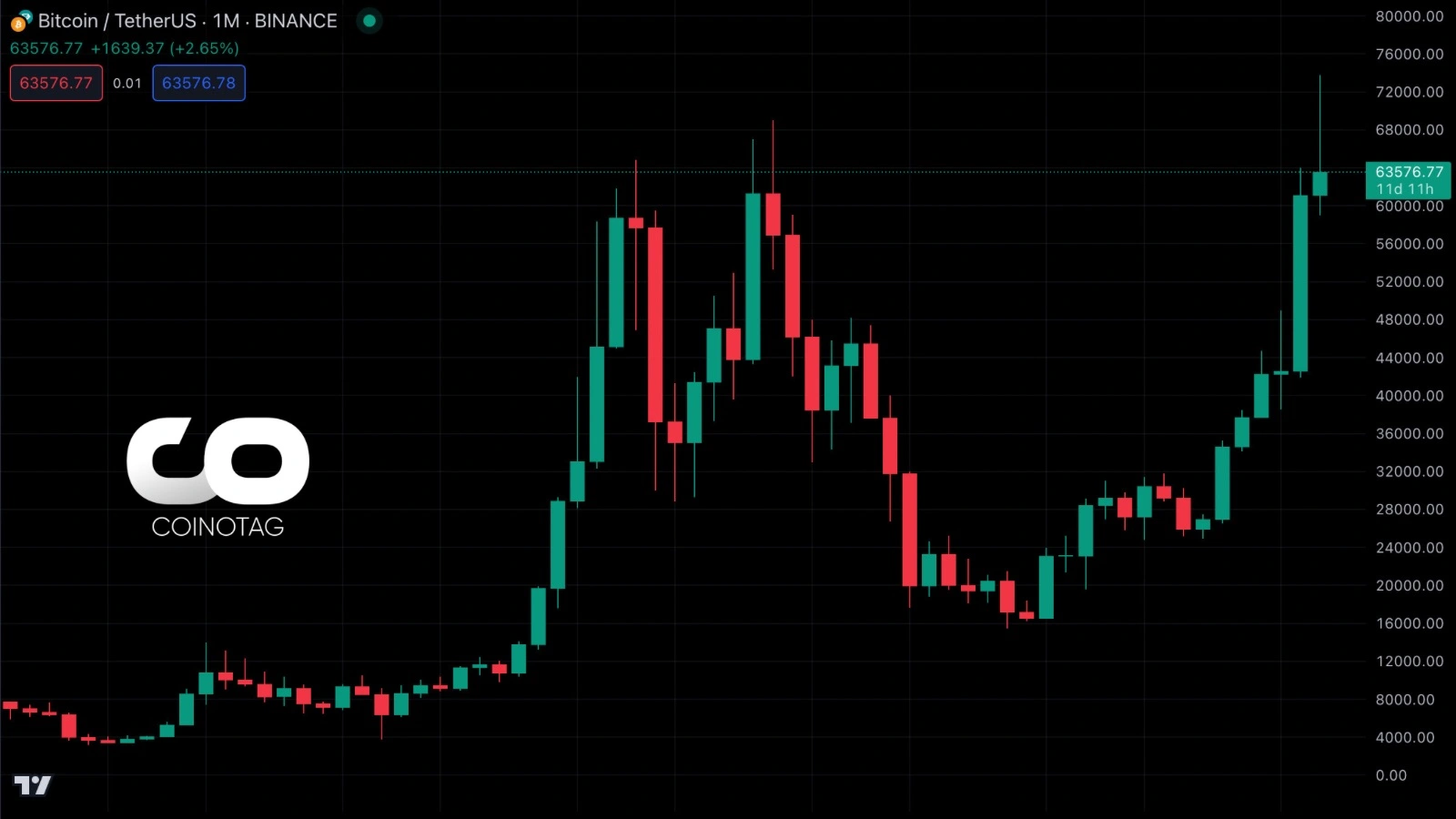| COINOTAG recommends • Exchange signup |
| 💹 Trade with pro tools |
| Fast execution, robust charts, clean risk controls. |
| 👉 Open account → |
| COINOTAG recommends • Exchange signup |
| 🚀 Smooth orders, clear control |
| Advanced order types and market depth in one view. |
| 👉 Create account → |
| COINOTAG recommends • Exchange signup |
| 📈 Clarity in volatile markets |
| Plan entries & exits, manage positions with discipline. |
| 👉 Sign up → |
| COINOTAG recommends • Exchange signup |
| ⚡ Speed, depth, reliability |
| Execute confidently when timing matters. |
| 👉 Open account → |
| COINOTAG recommends • Exchange signup |
| 🧭 A focused workflow for traders |
| Alerts, watchlists, and a repeatable process. |
| 👉 Get started → |
| COINOTAG recommends • Exchange signup |
| ✅ Data‑driven decisions |
| Focus on process—not noise. |
| 👉 Sign up → |
- As the Bitcoin halving approaches, institutional interest in BTC reaches an all-time high.
- Recent spot Bitcoin ETF approvals in the U.S. amplify demand, potentially reshaping market dynamics.
- Analysts ponder the impact of institutional adoption on Bitcoin’s traditional volatility and price discovery cycles.
In convergence, Bitcoin’s upcoming halving intersects with soaring institutional demand, signaling potentially transformative shifts in the cryptocurrency’s supply-demand dynamics and broader market implications.
The Halving: Bitcoin’s Deflationary Mechanism

Bitcoin’s programmed halving event, reducing miner rewards by half every 210,000 blocks, ensures a predictable and diminishing new supply, reinforcing its deflationary nature. This scarcity mechanism has historically triggered significant price movements, with the upcoming halving anticipated to further test Bitcoin’s market resilience amid increased institutional engagement.
Institutional Interest Peaks Amid ETF Launches
Spot Bitcoin ETFs, recently greenlit in the United States, have magnetized a staggering $12 billion in net inflows, underscoring institutional investors’ growing appetite for Bitcoin exposure. This surge in demand, juxtaposed with the halving’s supply cut, sets the stage for intriguing market developments, as institutions and retail investors alike navigate the evolving crypto landscape.
| COINOTAG recommends • Professional traders group |
| 💎 Join a professional trading community |
| Work with senior traders, research‑backed setups, and risk‑first frameworks. |
| 👉 Join the group → |
| COINOTAG recommends • Professional traders group |
| 📊 Transparent performance, real process |
| Spot strategies with documented months of triple‑digit runs during strong trends; futures plans use defined R:R and sizing. |
| 👉 Get access → |
| COINOTAG recommends • Professional traders group |
| 🧭 Research → Plan → Execute |
| Daily levels, watchlists, and post‑trade reviews to build consistency. |
| 👉 Join now → |
| COINOTAG recommends • Professional traders group |
| 🛡️ Risk comes first |
| Sizing methods, invalidation rules, and R‑multiples baked into every plan. |
| 👉 Start today → |
| COINOTAG recommends • Professional traders group |
| 🧠 Learn the “why” behind each trade |
| Live breakdowns, playbooks, and framework‑first education. |
| 👉 Join the group → |
| COINOTAG recommends • Professional traders group |
| 🚀 Insider • APEX • INNER CIRCLE |
| Choose the depth you need—tools, coaching, and member rooms. |
| 👉 Explore tiers → |
Regulatory Landscape and Economic Theories
The SEC’s cautious approach to cryptocurrency regulation, particularly Ethereum’s ambiguous classification, contrasts starkly with its acceptance of Bitcoin ETFs. This regulatory dichotomy underscores the complex interplay between innovation, market adoption, and oversight, challenging traditional economic theories as crypto ventures into uncharted territories of supply, demand, and value perception.
Macro Factors and Bitcoin’s Price Trajectory

| COINOTAG recommends • Exchange signup |
| 📈 Clear interface, precise orders |
| Sharp entries & exits with actionable alerts. |
| 👉 Create free account → |
| COINOTAG recommends • Exchange signup |
| 🧠 Smarter tools. Better decisions. |
| Depth analytics and risk features in one view. |
| 👉 Sign up → |
| COINOTAG recommends • Exchange signup |
| 🎯 Take control of entries & exits |
| Set alerts, define stops, execute consistently. |
| 👉 Open account → |
| COINOTAG recommends • Exchange signup |
| 🛠️ From idea to execution |
| Turn setups into plans with practical order types. |
| 👉 Join now → |
| COINOTAG recommends • Exchange signup |
| 📋 Trade your plan |
| Watchlists and routing that support focus. |
| 👉 Get started → |
| COINOTAG recommends • Exchange signup |
| 📊 Precision without the noise |
| Data‑first workflows for active traders. |
| 👉 Sign up → |
Amid fluctuating interest rates and economic uncertainties, Bitcoin’s price action reveals its nuanced relationship with broader financial markets. Despite potential susceptibility to Fed rate adjustments, Bitcoin’s enduring appeal as a hedge against inflation and its intrinsic value proposition remain pivotal to its demand, especially as institutional adoption grows.
Adoption Beyond Institutions: The Masses’ Role
While institutional participation introduces new capital and credibility to Bitcoin, the asset’s utility, adoption rate, and stability ultimately hinge on widespread use and acceptance. The mass adoption of cryptocurrencies, driven by tangible use cases and accessibility, may offer a more definitive answer to Bitcoin’s long-term value and its role within the broader financial ecosystem.
| COINOTAG recommends • Traders club |
| ⚡ Futures with discipline |
| Defined R:R, pre‑set invalidation, execution checklists. |
| 👉 Join the club → |
| COINOTAG recommends • Traders club |
| 🎯 Spot strategies that compound |
| Momentum & accumulation frameworks managed with clear risk. |
| 👉 Get access → |
| COINOTAG recommends • Traders club |
| 🏛️ APEX tier for serious traders |
| Deep dives, analyst Q&A, and accountability sprints. |
| 👉 Explore APEX → |
| COINOTAG recommends • Traders club |
| 📈 Real‑time market structure |
| Key levels, liquidity zones, and actionable context. |
| 👉 Join now → |
| COINOTAG recommends • Traders club |
| 🔔 Smart alerts, not noise |
| Context‑rich notifications tied to plans and risk—never hype. |
| 👉 Get access → |
| COINOTAG recommends • Traders club |
| 🤝 Peer review & coaching |
| Hands‑on feedback that sharpens execution and risk control. |
| 👉 Join the club → |
Conclusion
The interplay between Bitcoin’s halving and burgeoning institutional interest heralds a pivotal moment for the cryptocurrency. As the market anticipates the halving’s effects amid heightened demand, Bitcoin’s journey offers valuable insights into the dynamics of scarcity, regulatory frameworks, and the transformative potential of institutional involvement. With every cycle, Bitcoin’s evolving narrative continues to captivate and challenge both enthusiasts and skeptics, underscoring the revolutionary essence of blockchain technology and its impact on the future of finance.
| COINOTAG recommends • Members‑only research |
| 📌 Curated setups, clearly explained |
| Entry, invalidation, targets, and R:R defined before execution. |
| 👉 Get access → |
| COINOTAG recommends • Members‑only research |
| 🧠 Data‑led decision making |
| Technical + flow + context synthesized into actionable plans. |
| 👉 Join now → |
| COINOTAG recommends • Members‑only research |
| 🧱 Consistency over hype |
| Repeatable rules, realistic expectations, and a calmer mindset. |
| 👉 Get access → |
| COINOTAG recommends • Members‑only research |
| 🕒 Patience is an edge |
| Wait for confirmation and manage risk with checklists. |
| 👉 Join now → |
| COINOTAG recommends • Members‑only research |
| 💼 Professional mentorship |
| Guidance from seasoned traders and structured feedback loops. |
| 👉 Get access → |
| COINOTAG recommends • Members‑only research |
| 🧮 Track • Review • Improve |
| Documented PnL tracking and post‑mortems to accelerate learning. |
| 👉 Join now → |









